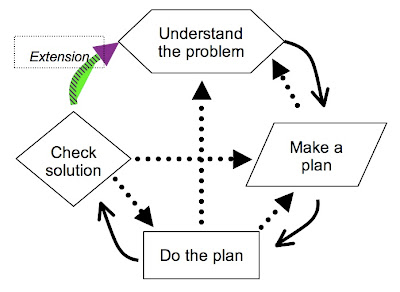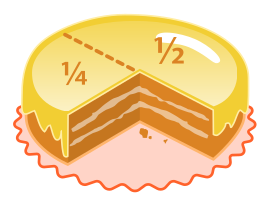
MAT 156 Math Instruction
Polya's 4 Steps to Solve a Problem

4 Steps
Understand the Problem
Devise a Plan
Carry Out the Plan
Look Back
Examples of Problem Solving Plans
equations
working backwards (input/output problem)
make a table/diagram
identify a subgoal
guess & check
indirect/direct resasoning
Sum of Sequential Numbers
Normal Sequence
S = 1+2+3+4+5...+100
1+100=101, 2+99 =101, 3+98=101...
So there are 100 sums that equal 101
2S = 100 x 101
S = (100 x 101)/2
S = 5,050
Even
S = 2+4+6+8+...+100
Odd
S = 1+3+5+7...+101
Main topic
Numeration Systems

Roman Numerals
I
= 1
V
= 5
X
= 10
L
= 50
C
= 100
D
= 500
M
= 1,000
Arabic
Tally Marks
Bases
Chinese
One-to-One Correspondences
Outfit example:
2 pants = blue, brown; 3 shirts = yellow, red, green
Make a table or tree
Blue - blue/yellow. blue/red, blue/green
Brown - brown/yellpw, brown/red, brown/green
2 pants & 2 shirts = 6 possible outfits
Simple Vocabulary
Addition
addends
sum
subtraction
difference/remainder
subtrend
minuend
multiplication
factors
product
division
dividend
diviisor
quotient
function
f(x)=x+2; (1,3)(2,4)(3,5)
Every domain (input, x) has exactly one range (output, y)
Order of Operations
P
Parenthesis
E
Exponents
M
Multiplication
D
Division
A
Addition
S
Subtraction
Properties
Associative
Commutative
Distributive
Identity
of One - addition/mulitiplication
of Zero - addition/ multiplication
Closure
Prime & Composite Numbers
Rainbow

Factor Trees

Color Map

Subtopic
Least Common Multiple & Greatest Common Denominator
Intersection of Sets
20: 1, 2, 4, 5, 20
32: 1, 2, 4, 8, 32
40: 1, 2, 4, 5, 8, 10
Number Line
Ladder Method

Subtopic
Prime Factorization
Subtopic
Adding & Subtracting Integers
Chip Model
Number Line
Equations
5 + (-6) = -1
Understanding Addition and Subtraction
Subtraction of Whole Numbers
Manipulatives, then Paper & Pencil
counting back/on
fact families
take away models
counting blocks
doubles
tens
number line
Number Sequences
Arithmetic
addition/subtraction
an = a1+(n-1)d
Fibonacci
previous term + current term = next term in the sequence
1, 2, 3, 5, 8, 13...
Geometric
multiplication/division
an = a1r^n-1
Finding the nth Term

Venn Diagrams

Inverse Operations
Multiplication is the inverse of division
Addition is the inverse of subtraction
Understanding Multiplication & Division
Mental Calculation
32 x 6 = (30x6 )+ (2x6) = 180 + 12 = 92
Repeated Addition
3 x 4 = 3+3+3+3
Long Division
D
Divide
M
Multiply
S
Subtract
C
Check if less
B
Bring down
C
Circle
Functions
Ordered Pairs
Equation
Graph
Evaluate a Function
f(x) = x+2
f(1) = (1) + 2
f(2) = (2) + 2
f(3) = (3) + 2
Make a Table
Graph

Subtopic
Ordered Pairs
Arrow Diagram

Subtopic
Main topic
Subtopic
Subtopic
Subtopic
Subtopic
Subtopic
Subtopic
Subtopic
Main topic
Subtopic
Subtopic
Subtopic
Subtopic
Subtopic
Subtopic
Subtopic
Subtopic
Subtopic
Subtopic
Fractions
Fraction Diagrams
2-D Parts of a Whole

3-D Example
Number Line
-3...-2...-1...0...1...2...3

Subtopic
Rounding Fractions
4 6/7 + 5 2/9 =
5 + 5 =
= 10
Decimals to Fractions, etc.
Equivalent Fractions
3/4 = 6/8 = 12/16
Adding & Subtracting Fractions

Fraction Bars
1/2 + 1/2 = 1

Subtopic
Vocabulary
Whole
Part
Fraction
Numerator
Denominator
